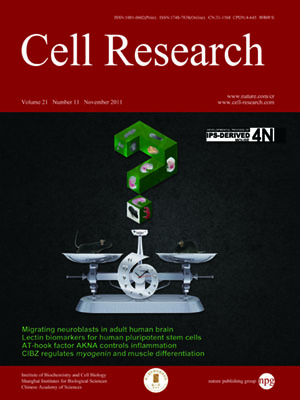
Advanced Search
Submit Manuscript
Advanced Search
Submit Manuscript
Volume 21, No 11, Nov 2011
ISSN: 1001-0602
EISSN: 1748-7838 2018
impact factor 17.848*
(Clarivate Analytics, 2019)
Volume 21 Issue 11, November 2011: 1591-1604
Xiaojia Ge1, Craig McFarlane2, Anuradha Vajjala1, Sudarsanareddy Lokireddy1, Zhi Hui Ng1, Chek Kun Tan1, Nguan Soon Tan1, Walter Wahli3, Mridula Sharma4
1School of Biological Sciences, Nanyang Technological University, 60 Nanyang Drive, Singapore
2Singapore Institute for Clinical Sciences, Agency for Science, Technology and Research (A*STAR), Brenner Centre for Molecular Medicine, 30 Medical Drive, Singapore 117609
3Center for Integrative Genomics, NCCR Frontiers in Genetics, University of Lausanne, Lausanne, Switzerland
4Department of Biochemistry, Yong Loo Lin School of Medicine, National University of Singapore, Singapore
Correspondence: Ravi Kambadur,(KRavi@ntu.eud.sg)
TGF-β and myostatin are the two most important regulators of muscle growth. Both growth factors have been shown to signal through a Smad3-dependent pathway. However to date, the role of Smad3 in muscle growth and differentiation is not investigated. Here, we demonstrate that Smad3-null mice have decreased muscle mass and pronounced skeletal muscle atrophy. Consistent with this, we also find increased protein ubiquitination and elevated levels of the ubiquitin E3 ligase MuRF1 in muscle tissue isolated from Smad3-null mice. Loss of Smad3 also led to defective satellite cell (SC) functionality. Smad3-null SCs showed reduced propensity for self-renewal, which may lead to a progressive loss of SC number. Indeed, decreased SC number was observed in skeletal muscle from Smad3-null mice showing signs of severe muscle wasting. Further in vitro analysis of primary myoblast cultures identified that Smad3-null myoblasts exhibit impaired proliferation, differentiation and fusion, resulting in the formation of atrophied myotubes. A search for the molecular mechanism revealed that loss of Smad3 results in increased myostatin expression in Smad3-null muscle and myoblasts. Given that myostatin is a negative regulator, we hypothesize that increased myostatin levels are responsible for the atrophic phenotype in Smad3-null mice. Consistent with this theory, inactivation of myostatin in Smad3-null mice rescues the muscle atrophy phenotype.
Cell Research (2011) 21:1591-1604. doi:10.1038/cr.2011.72; published online 19 April 2011